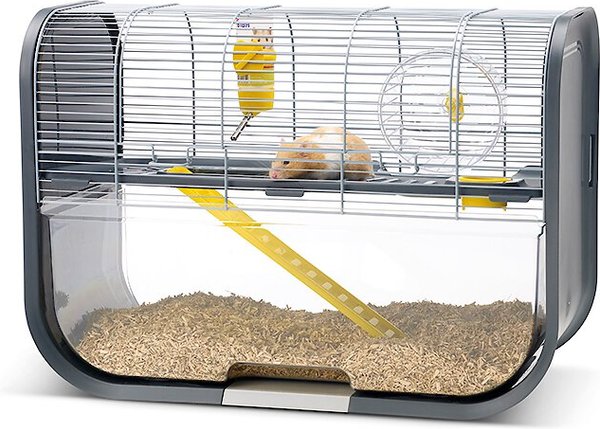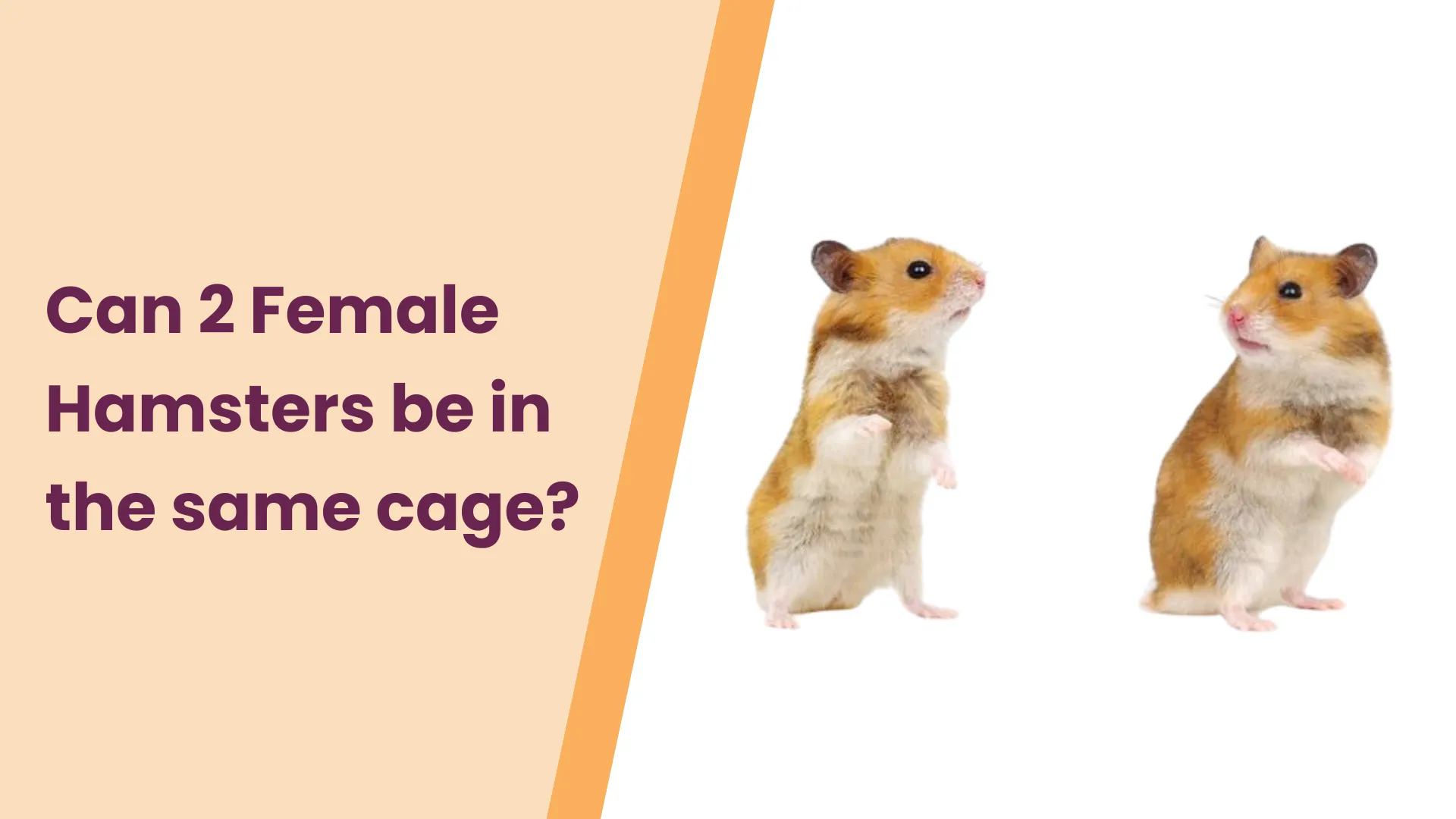Can 2 Female Hamsters be in the Same Cage?
Have you ever wondered if your two female hamsters can share the same cozy cage space, just like the best of friends? We’re about to embark on a fascinating journey into the world of these small, furry companions. While hamsters are known for their adorable, solitary burrowing and wheel-running habits, the possibility of having two females share a cage opens up a world of curiosity and companionship.
In this comprehensive guide, we’ll explore the dynamics of female hamster compatibility, helping you understand the intricacies of their social behavior and offering valuable insights into whether these little roommates can peacefully coexist.
So, grab your magnifying glass, and let’s delve into the enchanting world of female hamster friendships!
Understanding Female Hamster Behavior
Female hamsters, often celebrated for their sweet and gentle disposition, might seem like the ideal candidates for cage-sharing camaraderie. But before we dive into the prospect of a harmonious hamster sorority, it’s essential to grasp their natural behavior.
The Sisterly Side of Female Hamsters: Female hamsters are generally more sociable than their male counterparts. They often display a sisterly bond, which makes them more amenable to cohabiting. However, like any roommate situation, compatibility can’t be assumed universally. Each hamster has its unique personality, and some might embrace the idea of a cage companion with open paws, while others may prefer their solitary kingdoms.
A Dash of Dominance: One key factor to consider in understanding female hamsters’ interactions is their innate territorial instincts. In the wild, hamsters carve out their burrows and territories, and this territorial streak can carry over into a shared cage setting. Occasionally, one hamster might seek to establish dominance over the other, leading to some squabbles or tiffs as they work out their pecking order.
Age and Size Matters: When considering whether two female hamsters can share a cage, their age and size come into play. Younger hamsters often adapt more easily to cage companions, while older ones might be set in their ways and less inclined to accept a new roommate. Similarly, size differences between the hamsters can influence compatibility. If one hamster significantly outweighs or intimidates the other, it can lead to dominance struggles.
The Power of Gradual Introductions: To improve the chances of a successful cohabitation, it’s crucial to introduce the two female hamsters gradually. Rushing the process can cause stress and tension. Start with separate cages placed near each other so they can become accustomed to each other’s scent and presence. Over time, you can allow them to meet in a neutral territory outside of their cages while closely monitoring their interactions.
In the next sections, we’ll delve deeper into the signs of compatibility and incompatibility between female hamsters and share practical tips for ensuring a peaceful coexistence in your furry sorority.
Compatibility of Female Hamsters
The question of whether two female hamsters can share the same cage often hinges on the inherently social nature of these delightful rodents. While no two hamsters are exactly alike, there are general trends in female hamster behavior that can guide your expectations.
The Harmony of Sisterhood: Female hamsters, often regarded as the “sorority sisters” of the hamster world, tend to be more social and accommodating compared to their male counterparts. They’re often more willing to embrace the idea of sharing living quarters. It’s not uncommon for female hamsters to form close bonds, displaying companionship, mutual grooming, and shared nesting. These heartwarming behaviors can be a testament to the remarkable connections that can develop among female hamsters.
Individual Personalities Matter: However, it’s essential to remember that hamsters, like humans, have their unique personalities. Some female hamsters might be sociable and thrive in the presence of a cage companion. They’ll engage in friendly antics, curl up together for cozy naps, and seem like the best of friends. On the other hand, some hamsters may prefer their solitude, and attempts to introduce them to a roommate might lead to stress and squabbles.
Compatibility Can Vary: The key takeaway is that compatibility between female hamsters can vary from one pair to another. It’s often a matter of trial and observation to determine whether your two female hamsters will live together in perfect harmony or prefer their own space.
A Word of Caution: While female hamsters are generally more sociable, it’s important to exercise caution and be prepared for all possible outcomes. Even if two female hamsters have been happily cohabiting, it’s not uncommon for a change in their dynamics to occur as they age. Monitoring their behavior and having a contingency plan, such as a separate cage, is a prudent approach.
In the next sections, we’ll explore the various factors to consider when deciding to house two female hamsters together, including their age, size, and the gradual introduction process.
Factors to Consider
The decision to house two female hamsters together involves several critical considerations. While their sociable nature offers promise, understanding the nuances of these factors can make all the difference in creating a harmonious living environment for your furry companions.
1. Age and Size:
Youthful Adaptability: Younger female hamsters tend to be more adaptable to cage-sharing. Their playful, inquisitive natures can make the transition smoother, as they’re often open to making new friends.
Maturity Matters: On the other hand, older hamsters may be less enthusiastic about sharing their space. As hamsters age, they can become more set in their ways and may prefer solitude.
Size Dynamics: Keep an eye on size differences between your hamsters. If one is significantly larger or more dominant than the other, it can lead to territorial disputes and hinder compatibility.
2. Gradual Introductions:
Patience is Key: Rushing the introduction process can lead to stress and potential conflicts. The first step is to place their cages near each other, allowing them to become accustomed to each other’s scent.
Neutral Ground: When the time comes for a face-to-face encounter, choose a neutral territory outside of their cages. This avoids triggering territorial instincts.
Close Supervision: During these initial meetings, closely supervise their interactions. It’s an opportunity to gauge their responses and ensure their safety.
3. Compatibility Trials:
Observing Behavior: Pay attention to the behavior of your hamsters during these encounters. Positive signs include mutual grooming, shared nesting, and peaceful coexistence.
Red Flags: If you notice aggressive behaviors, such as biting, chasing, or loud squeaks, it’s essential to intervene and, if necessary, consider housing them separately.
4. Separate Living Arrangements:
Always Be Prepared: Even if your female hamsters appear compatible, it’s wise to have a backup plan in case their relationship sours. A separate cage should be readily available.
By considering these factors, you’ll be better equipped to decide whether your two female hamsters can peacefully coexist. It’s important to remember that each hamster is a unique individual, and their compatibility is not guaranteed. In the subsequent sections, we’ll delve into the signs of compatibility and incompatibility, as well as share practical tips for nurturing a peaceful coexistence between your furry friends.
Separation as a Precaution
When considering whether two female hamsters can peacefully share a cage, one valuable precautionary step is to prepare for the unexpected. Even if everything appears to be going well during the initial stages of their cohabitation, it’s essential to have a backup plan in place.

Why Prepare for Separation?
Hamsters, like people, can have their moods and may experience changes in their relationships over time. What may begin as a harmonious companionship might evolve into tension or conflict as the hamsters age or their personalities develop. This is why being ready for separation is a prudent approach.
The Importance of a Separate Cage:
Having a separate cage readily available ensures the safety and well-being of your hamsters. In case they exhibit signs of incompatibility, such as frequent fights or severe stress, you can quickly intervene and separate them.
Monitoring Behavior:
It’s crucial to keep a close eye on your hamsters’ behavior during the early stages of cohabitation. While you hope for a positive and peaceful living arrangement, you should also be vigilant for any signs of aggression. Hamsters are territorial creatures by nature, and disputes can arise unexpectedly.
How to Separate Them:
If the need for separation arises, you can move one of the hamsters to the prepared separate cage. Ensure both cages are well-equipped with the essentials: fresh bedding, food, water, and toys. Remember, a failed attempt at cohabitation doesn’t mean your hamsters can’t enjoy happy lives separately. It’s important to prioritize their comfort and well-being.
In the following sections, we will discuss how to observe the interactions between your female hamsters and understand the signs of both compatibility and incompatibility. By staying vigilant and being prepared for all scenarios, you can provide the best possible care for your beloved hamsters.
Observing Their Interaction
When you’re considering housing two female hamsters together, a crucial aspect of the process is observing their interactions. Monitoring their behavior during the initial stages of their cohabitation is the key to ensuring a harmonious living environment for your furry companions.
The Power of Patience: The introduction of two female hamsters is not a one-and-done task. It’s a gradual process that requires your patience and keen observation. Rushing the interaction can lead to stress, anxiety, and potential conflicts. Take your time, and let your hamsters set their own pace.
Signs of Compatibility
As you watch your hamsters interact, look for positive signs that indicate compatibility:
Mutual Grooming: If your hamsters engage in grooming each other, it’s a heartwarming sign of friendship and social bonding.
Shared Nesting: If they build a nest together or sleep side by side, it’s a clear indication that they’re comfortable in each other’s presence.
Playful Behavior: Playfulness, like chasing each other without aggression, shows that your hamsters are enjoying each other’s company.
Remember, each pair of female hamsters is unique. Some may become inseparable friends, while others might prefer their solitary domains. Your role is to provide them with the best environment for their individual needs and preferences.
Tips for a Peaceful Coexistence
Creating a harmonious environment for two female hamsters sharing a cage involves more than just hope and wishful thinking. By taking the right steps and offering the ideal conditions, you can encourage a peaceful coexistence between your furry friends.
1. Provide Adequate Space
Room to Roam: Make sure the cage provides ample space for both hamsters to explore, exercise, and establish their territories. A larger cage reduces the likelihood of territorial disputes.
2. Offer Hiding Spots
Cozy Retreats: Include multiple hiding spots and shelters in the cage. This allows hamsters to have their private space when needed and reduces potential stress.
3. Separate Food and Water Dishes
Individual Dining: Give each hamster its food and water dish to prevent conflicts over resources. This also ensures that both hamsters receive proper nutrition.
4. Provide Enrichment and Toys
Keep Them Busy: Offer a variety of toys and items for mental stimulation and physical activity. Hamsters that are engaged and content are less likely to engage in conflict.
5. Clean the Cage Regularly
Fresh and Tidy: Maintain a clean cage by regularly changing bedding and removing waste. A clean environment contributes to the well-being of your hamsters and reduces stress.
6. Love and Care
TLC: Shower your hamsters with love and care. A positive and nurturing environment, along with plenty of affection, can contribute to their overall happiness.
By following these tips, you’ll be well-prepared to foster a peaceful coexistence between your two female hamsters. Remember that patience, observation, and responsiveness to their needs are key to creating a loving and happy environment for your beloved companions.
Conclusion
In the enchanting world of female hamsters, the question of whether two can share the same cage is met with a blend of hope and caution. These furry sorority sisters can indeed become the best of friends, sharing grooming sessions and cozy nesting spots. However, every hamster carries a unique personality, and compatibility can vary.
As you embark on this journey with your beloved companions, remember that patience is your closest ally. Observation is your guide, and love is your anchor. By offering the right conditions, a watchful eye, and a loving heart, you can nurture a harmonious environment for your female hamsters.
Whether they become inseparable friends or prefer their solitude, the ultimate goal is to provide a safe and joyful space for them to thrive. Be vigilant, be prepared, and always prioritize their well-being. Consulting a professional when needed ensures you’re on the right path.
So, go ahead, explore the world of female hamster friendships, and let the heartwarming bonds that can develop within those tiny paws remind you of the beauty of companionship, even in the smallest of creatures.
“We’re thrilled to have shared insights into the intriguing world of female hamster companionship with you. Your experiences, questions, and stories are not only valuable but also incredibly enriching for our community of hamster enthusiasts. Have you had the joy of witnessing a heartwarming friendship between your female hamsters? Or perhaps you’re in the process of introducing them, and you’d like to seek advice or share your progress?
Please feel free to drop your thoughts in the comments section below. We’d love to hear from you and offer our guidance where needed. And if you’ve found this information helpful, don’t forget to share this post with fellow hamster lovers on your favorite social platforms, so they can benefit from these insights too. Together, we can create a supportive hub for all things hamster-related and continue to learn from each other’s experiences. Thank you for being a part of our hamster care community!” – Hamsterpit.







